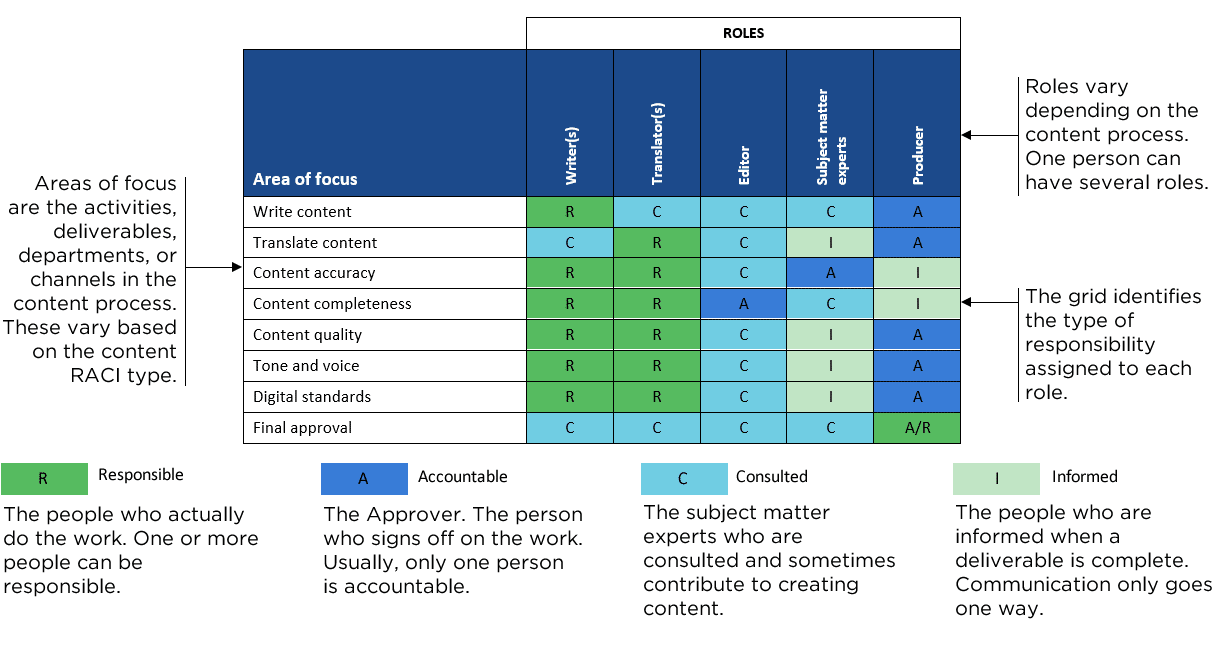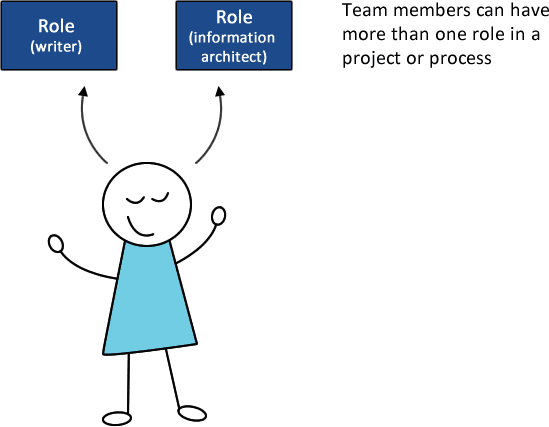
When content processes don't work
As a manager of a content team, you may find yourself having a head-on-desk moment at some point, frustrated by content processes that never seem to work.
“Why are we always fielding content requests in crisis mode? We spent all this time creating a content plan that no one follows.”
Often, the frustration stems from the lack of clarity around roles and responsibilities. In other words, who does what.
Companies of all sizes, from mid-level to enterprise, face exactly same challenge. You’re not alone.
RACIs to the rescue
Content roles and responsibilities need to communicate content leadership, ownership, and execution on an ongoing basis. The best way of doing this is through a responsibility matrix, or RACI (stands for Responsible, Accountable, Consulted, and Informed).
A RACI chart helps clarify who does what by mapping responsibilities, tasks, or deliverables to roles. It’s especially useful for cross-functional teams and projects that involve many departments.
RACIs help to:
- Communicate roles and responsibilities
- Reinforce content processes and workflow
- Support team structure and cross-team structures
- Identify content leadership
- Identify subject matter expertise
- Identify resources that are under or over-allocated.
Do you need a RACI?
Yes, you do! All organizations, regardless of industry or size should clearly define roles and responsibilities.
For content teams, a RACI is one of the foundations of good governance and goes hand in hand with clear content processes. You can’t have one without the other.
If your content processes are to survive and thrive, everyone needs to be pulling on their oar at the same time. If they don’t, you’ll end up going in circles.
Common problems when content roles and responsibilities aren’t defined
Content team members are either “sort of” or “not at all” confident they are talking to the right people and teams.
We hear this often from our enterprise clients. When team members come from many departments, don’t meet regularly, or are located in different offices, the people responsible for content don’t know who to go to for subject matter expertise. The result is confusion.
Content updates and priorities aren’t understood or enforced.
An extension of not knowing who does what or who to ask, is that nothing gets done at all. The task or activity gets put on hold, relegated to the backburner, and gets elevated only when it becomes a crisis.
Content creators become protective of their content, and are unwilling to let go or share responsibility.
Sometimes writers and subject experts don’t want to give up control. They simply don’t trust that their content will get published unless they shepherd it personally through the process. When people refuse to relinquish control, the content creation inefficient, and quality suffers.
Content creators are overwhelmed by the amount of work they have, or they feel they don’t have the skill sets needed to do the work
Content writers or producers are often the most visible and easily understood roles in a large or complex content process. It’s like having a target on your back. Content coming “over the wall” happens when people across the enterprise don’t fully understand how content gets made.
Parts of a RACI
While RACIs are used in all areas of business, content RACIs focus on the needs of content teams and processes.
A basic RACI for a content team could look something like this:
Guidelines for creating a content RACI
Understanding and defining roles and responsibilities are part of the foundation of your content strategy. The following guidelines can help you make an effective content RACI for your organization. Get more help by downloading our Content RACI templates.
Associate responsibilities with roles, rather than with specific people
- One person can assume multiple roles. For example, a product manager can have the role of both content creator and subject matter expert. A person may have the job title of UX strategist, but one of their roles is writing strategic plans.
Make sure people with Rs (Responsible) aren’t overloaded
- If a role has many Rs (Responsible), make sure those people don’t have more work than they can handle. If one deliverable has many Rs, consider breaking down tasks into smaller activities to give team members more control.
Make sure there is only one A (Accountable) for each role
- There should be only one A (Accountable) for each role so that sign-off is clear. If an activity doesn’t have an A, then it’s at risk of not meeting project goals. In some situations, more than one A may be necessary if there are multiple approvers for a project but then be aware that extra time may be needed to gather all approvals.
Balance the number Cs (Consulted) for each role
- To many Cs (Consulted) for a role can result in content that gets bogged down by subject matter experts. Too few Cs can result in poor quality through lack of accuracy or not meeting business goals.
Make sure people with Is (Informed) understand they can’t give or withhold approval
- People who are assigned an I (Informed) role should understand that they are only advised when a deliverable is complete and cannot make changes to or hold up the approval process.
Content RACI examples
In addition to the basic content RACI, these three RACI models meet different content needs.
Content leadership or high-level RACI
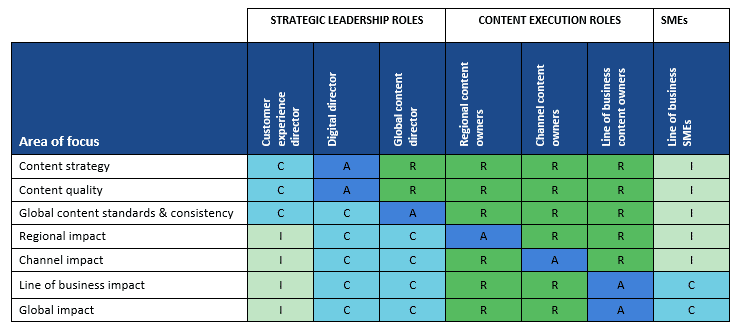
This is an example only. Actual roles will change for every project.
A high-level RACI helps you understand and communicate how different departments contribute to the content experience.
In this model, one piece of content can be considered for business needs, channel needs, regional needs, global needs, and so on.
A content leadership RACI requires a high degree of collaboration and communication across various content owners. Final content is not a distinct deliverable, but rather a result of a number of different deliverables from different departments and team members.
Channel-based content RACI
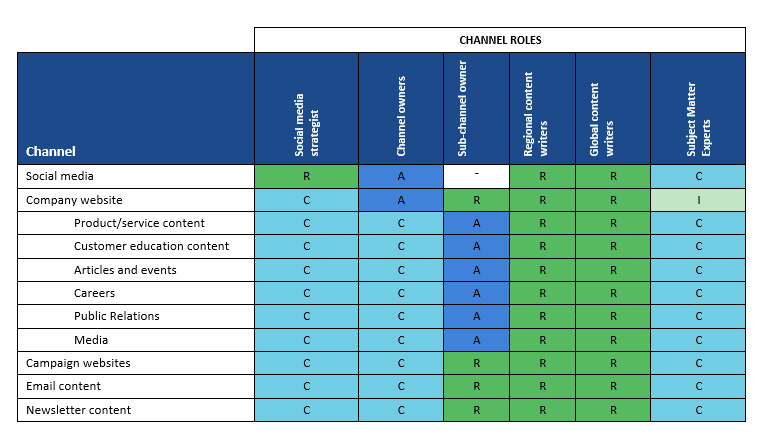
This is an example only. Actual roles will change for every project.
A channel-based RACI provides direction on content roles by channel.
Channel owners have the most responsibility for shaping content distributed through their channel. At the project level, the director of content may delegate accountability to others, usually the channel owner.
Complex project RACI
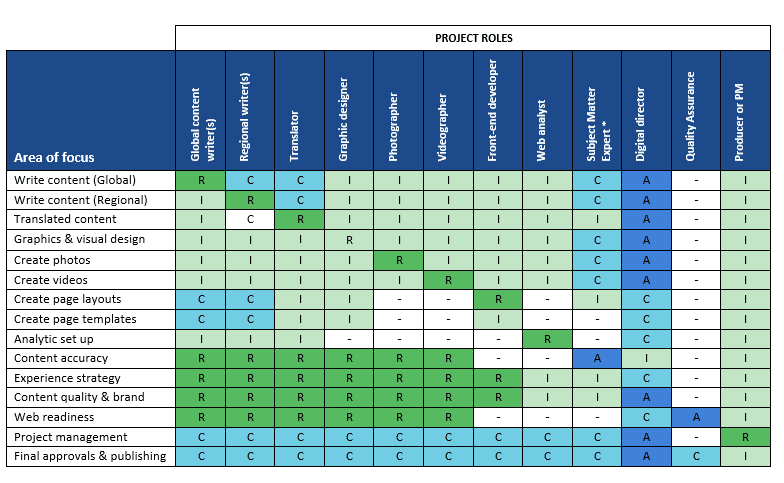
This is an example only. Actual roles will change for every project.
A project RACI is ideal for a large, complex content projects.
In this model, a subject matter expert is the person providing content requirements for their department or line of business. They may represent different business units, stores, the legal department, and so on.
What’s next
Content roles and responsibilities are only effective if you have a clear accountability and content processes in place. Every team member needs to be committed to use, and follow, RACIs either by agreement or because they’re required to. Having a project manager ensures everybody is doing their assigned role makes it easier.
Think of it this way: Why run a 10,000 metre race all on your own? When you pass the baton to a teammate, and they in turn pass it on again, you’ll finish the race in record time and not have run the whole way yourself. Phew!
Finally, if you’re creating a content RACI for the first time, run a small pilot project to see how it works. You’ll find things that don’t work, and a pilot gives you a chance to tweak and refine.
And, make sure your follow up and review roles and responsibilities at regular intervals as part of an overall governance plan.
Do you have any questions about how to create and use a content RACI? We’d love to hear them. Post your comments on LinkedIn, or connect with us on Twitter.
Further reading
Content toolkit: Content RACI Templates
Content teamwork: Aligning your people and process [Workshop slides]
Understanding the content maturity model
